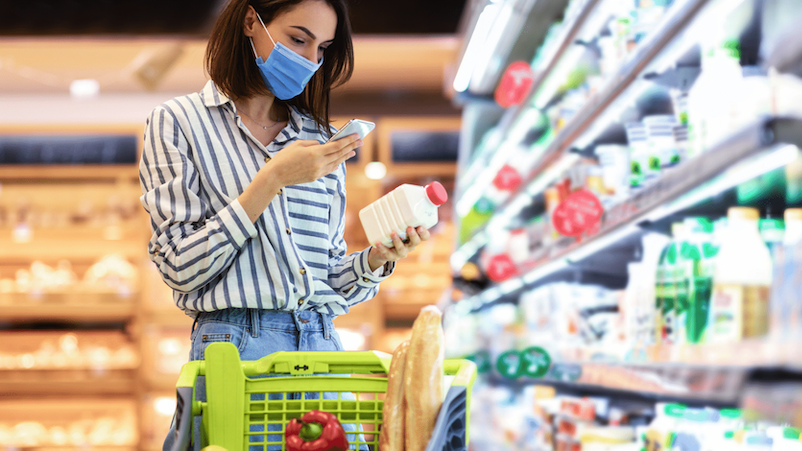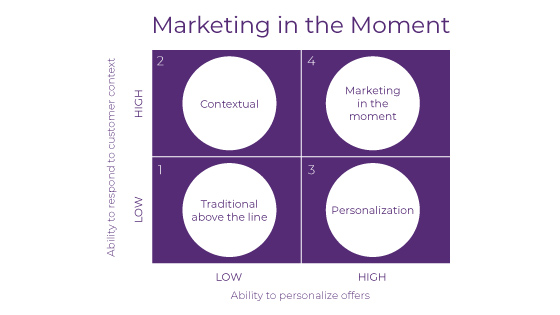Up next in retail marketing: Meeting customers ‘in the moment' – how to reach store shoppers when it really matters

Retailers harnessing personalisation capabilities via loyalty programmes are making major gains. But there is much greater upside for the smart operators.
Retailers who build digital connections with in-store customers through their phones can use behavioural and environmental triggers to contextualise personalised offers. This is creating a totally new form of customer engagement called “marketing in the moment.” Eagle Eye APAC General Manager Jonathan Reeve unpacks the opportunity for retail marketers.
Although the online channel accounts for less than 20% of retail sales, it takes the lion’s share of investment in digital marketing. For example, many retailers are now introducing subscription programs. It is striking that almost all follow Amazon’s lead by placing free delivery of online products at the heart of their proposition, rather than value delivered to customers in stores. It’s a similar story for other digital marketing activities. In the Australian App Store today, 14 of the top 20 retail apps aim to improve the online experience. In my inbox, 8 of the last 10 retailer emails relate to online offers.
The dearth of investment in digital marketing to in-store customers has been driven by both technical and cultural challenges. However, some retailers are starting to adopt a more balanced strategy by leveraging the power of customers’ smartphones to improve the in-store experience. A recent example has been Woolworths’ launch of an integrated payment option in its Everyday Rewards loyalty app. Using the QR code to pay at the till offers a shorter checkout process for customers using the app, thus encouraging shoppers to engage digitally in the store.
In this article I propose that retail advertising is on the cusp of a transformation as more retailers find ways to make in-store shopping a “phone out of pocket” activity. Retailers with a digital connection to store shoppers can combine existing personalisation capabilities with the ability to recognise a customer’s context in real-time. This is creating a totally new form of customer engagement that Tesco Clubcard founder Tim Mason has called, “marketing in the moment.” I believe this will be as transformative for retail advertising as “near me” search has been for search advertising, with 30 per cent of Google searches on mobile devices now involving location.
The current state of play
Advances in both digital technology and customer analytics have led to a dramatic shift in an omnichannel retailer’s ability to personalise promotions. Many retailers have kicked off personalisation capabilities, and some are now sending offers that are personalised for each customer’s preferences. Australian examples include the weekly personalised offers distributed by the grocery loyalty programs. Retailers using this model have seen significant increases in both digital engagement and offer redemption, as described in a BCG study, “The $70 Billion Prize in Personalized Offers”.
Missing the moment
However, there’s scope for much more. Even the most sophisticated retailers are sending out offers through a single context; for example, all customers receive their offers via email on the same day and at the same time every week, with the offers produced on a fixed weekly schedule. There are many downsides to this single context approach, because it does not account for myriad contextual factors when targeting a shopper. My colleague Joel Percy, who helps North American retailers to build marketing in the moment programs, has identified four key contexts that affect the optimal offer at any point in time:
- Environment. What is happening in the world right now for the customer? Weather, sporting events and community events?
- Location. Where is the customer at that moment in time? At home, in a store, near a store, on the subway, etc.?
- Activity. What is the customer doing right now? Are they in the app, browsing recipes, in the store viewing a shopping list?
- System triggers. What just happened in the retailer’s marketing platforms? For example, did the customer cross a loyalty threshold, receive a voucher, or engage over social media?
A typical starting point for retailers transitioning to marketing in the moment is to stop sending personalised offers on a fixed day for all customers and instead send the offers on the day that best aligns with each customer’s shopping patterns. A next step might be to vary the offers in response to environmental changes such as an unexpectedly warm day or a significant local sporting or cultural event.
Enter the matrix
To understand where different retailers sit, let’s look at a four-quadrant matrix of personalised offers for a retailer with physical stores.

First, in the bottom left quadrant (no. 1) sit traditional above-the-line offers. These are in-store offers available to all customers and typically promoted through mass market channels such as a paper catalogue or in-store displays. Here, every customer receives the same offer and via the same marketing tool, with no differentiation to reflect the context or the customer’s own preferences.
Moving into more contextual but unpersonalised offers, we come to quadrant no. 2, which would include a retailer that has geofenced its stores and triggers promotions when customers enter the doors. Typically, these retailers are delivering a one-size-fits-all offer for every customer and are missing the personalisation on top. In my view, the right question is not, “What should I do for every single customer who walks into the store?” but “What should I do for this individual when she walks into the store?”
Retailers that have personalised offers today can be found in quadrant no. 3, offering personalised content based on purchase history and the insights developed about preferences for products and rewards. However, as noted above, almost all retailers still send their personalised offers through a single context, with no variation to reflect insights about the customer’s current situation, like whether they are yet to shop or have just finished shopping, or what the weather is doing on that day.
In the top right, quadrant no. 4, sits “marketing in the moment,” a model where retailers deliver the optimal, personalised advertising message to a shopper at the most opportune time via the most relevant channel. It's delivered by combining several data points for each customer, such as purchasing patterns, app usage and demographics. Individual consumer data is viewed within a larger context, including seasonality, time of day, product availability, and the retailer's promotional goals. The model enables businesses to deliver customised advertising at the moment that best motivates consumers to purchase while meeting the retailer’s financial goals.
Imagine that a retailer knows that a certain customer has a preference for products in the barbecue meats category. When that shopper enter the store on a warm and sunny Saturday afternoon, their propensity for purchasing products in that category rises even higher. ”Marketing in the moment” might identify and deliver offers or suggestions for barbecue meats as soon as the customer enters the doors of the store.
What’s the context?
Although it’s still in its infancy, we believe “marketing in the moment” will evolve to allow retailers to reach in-store shoppers at the precise time when it matters most – right when the shopper is making their decision in the aisle of the store. Some overseas retailers are already pioneering personalised adverts at the shelf edge by delivering offers through “Scan & Go” self checkout apps, as these give visibility of a customer’s actions throughout the shopping trip.
As more store shoppers make their activity trackable through apps and other digital services, “marketing in the moment” capabilities will naturally increase for all retailers who want to reach shoppers where they want to be noticed – in the moment.
About Jonathan Reeve and Eagle Eye
Jonathan Reeve is General Manager APAC for Eagle Eye, a leading real-time loyalty, offers and subscriptions platform. Eagle Eye’s SaaS technology is used by clients including Asda, Coca-Cola, Diageo, JD Sports, John Lewis, Loblaws, Pret a Manger, Tesco, Virgin Group, The Warehouse Group and Woolworths. Jonathan has worked in retail businesses on three continents for more than 20 years and was part of the team that developed the operating model for Tesco.com in its early years.
Eagle Eye is hosting breakfast briefings on “Marketing in the moment” in Melbourne, Sydney and Auckland. To register, visit: https://resources.eagleeye.com/marketing-in-the-moment-anz-mi3
